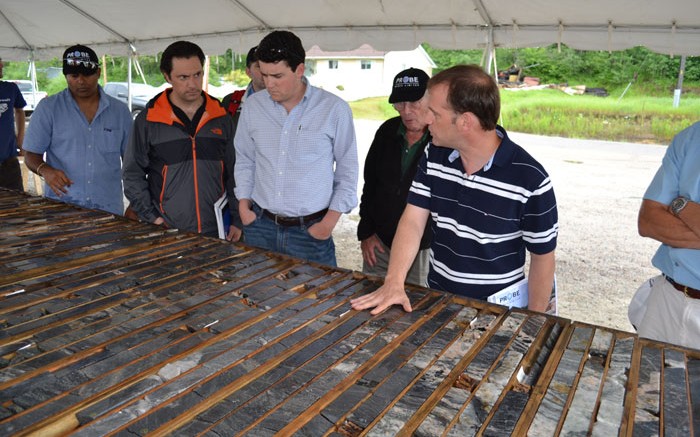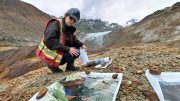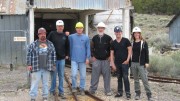CHAPLEAU, ONT. — Play the game of word association with anyone who has heard of the small town of Chapleau, located west of Timmins in northern Ontario, and lumber, wildlife and railcars are bound to come up.
But Probe Mines (TSXV: PRB) is adding a new word to that list: gold.
Since making a gold discovery here at its Borden Gold project in 2010, Probe has diligently worked to show that this part of the province, neglected by prospectors for the better part of the last century, indeed hosts hidden treasure.
For its first two years on the property, the Probe team was content to steadily outline what it believed to be a new large-tonnage, low-grade deposit — something respectable if not spectacular. Recently, however, it has discovered so much more.
“Over the last six months this has turned into a project that we hadn’t envisioned,” Probe’s CEO David Palmer says as we stand on the outcrop first used to identify the deposit.
He is referring to the recent discovery of a high grade zone that sits within the broader lower-grade envelope that made up the original resource estimate.
The discovery hole in the new zone, which begins on the eastern flank of the known deposit, returned 51 metres with an eye-catching average grade of 10.3 grams gold per tonne. That’s an order of magnitude higher than anything else the company had hit over its previous 2,000 metres’ worth of drilling.
“We already had a solid deposit on our hands. We thought it was a large lower grade deposit with higher grades than Osisko Mining’s Canadian Malartic but then we hit this high grade zone in the middle of it,” Palmer says. “So now we think maybe it is more like a Hemlo than an Osisko.”
So impressive were the results from the new zone that Palmer had a hard time believing them when they were first delivered to his desk.
“We had to keep getting them retested,” he laughs, “We just couldn’t believe that the grades could be that high over that many metres.”
If the assays didn’t convince him at first, the subsequent drill holes left little doubt that the company was on to something, as drilling success continued in a southeasterly direction.
It is now drilling along the shores of Borden Lake, chasing the trending mineralization beneath the waves, and it is still open along strike.
In all, since December of last year, the company has added 700 metres of high grade material along strike of the deposit, with plenty of potential to continue. Highlights from that drilling include: 25 metres grading 17.8 grams gold, 17.7 metres grading 12 grams gold and 27.1 metres grading 6.4 grams gold.
Those kinds of results have Palmer and his team noticeably exuberant — an emotion that has become too rare of late in the gold mining business.
And while others lament the decline in gold prices, Palmer is quick to point out a “silver lining”: with less capital flowing towards exploration drilling these days, prices for drilling services are plummeting. Just last year it cost Probe $165 per metre of drilling. This year it went down to $142 per metre, and Palmer is expecting another 5-10% reduction when it renews its contract for next year.
Assaying prices are falling, too. Assays are currently costing Probe just $35 per metre, a far cry from prices in the heyday of the gold boom just a few years ago.
And less demand for drilling and assaying services doesn’t just mean lower costs; it also means quicker turnaround times at the labs.
Another contributing factor to Probe management’s sunny disposition is the status of its balance sheet. Relative to the host of juniors scrambling for ways to find their next meal, Probe is the dragon sleeping on a hoard of gold.
The company began the year with $32 million in its treasury and then added a good chunk more by selling a stake in its equity to Agnico Eagle Mines (TSX: AEM; NYSE: AEM) for $15 million.
That tidy sum bought Agnico a 9.9% share of the company via a bit of creative financial engineering orchestrated by Probe.
The transaction involved three crucial steps: first, Probe sold the stock in question to a single investor that was looking for a tax credit. To get it, the investor paid $2 per share and then triggered the next step in the process by immediately donating the stock to a charity. The final leg of the deal saw Agnico come in and buy the stock from the charity for $1.50 per share.
So Probe received $2.00 for each of its shares, the private investor maximized a tax credit, the charity converted the stock to cash, and Agnico only paid $1.50 per share. It all added up to the rarely seen win-win-win-win scenario.
“Agnico is ‘strong hands’ so we don’t have to worry about that stock coming back to bite us. Plus having Agnico as a shareholder really validates the company,” Palmer says. “But we wouldn’t have done the deal at $1.50.”
No doubt the deal was also made smoother by the fact that Agnico and Probe were no strangers. The companies have some shared history via Agnico’s troubled Goldex mine outside Val d’Or, Que. While flooding at the mine back in 2011 was bad news for Agnico, it proved to be beneficial to Probe as the junior had long held a 5% net smelter return royalty on some satellite deposits at the site.
With the flooding of the main Goldex deposit, Agnico turned to those very satellite deposits to feed its already established mill. That meant those royalties suddenly had real-time value, and Probe was able to capitalize by selling the royalty to Agnico for $14 million in cash at the time of closing, another $2.5 million if production from the deposits goes over 17,320 oz. and then another $1.5 million should production exceed 20,320 oz. gold.
The deal closed last November and Palmer expects production go above the 20,320 oz. gold threshold by the middle of next year.
A town not known for gold
The Borden project sits 9 km outside of Chapleau, and that proximity brings some significant advantages on the infrastructure side. The project is only 1 km from the highway and power lines, and a railway line is a 10-minute drive from the property boundary.
And while Chapleau itself has never been known for gold, the broader region is no stranger to the metal: Iamgold’s (TSX: IMG; NYSE: IAG) Coté Lake deposit is 110 km to the southeast; Barrick Gold’s (TSX: ABX; NYSE: ABX) past-producing Renabie sits 70 km to the northwest; Argonaut Gold’s (TSX: AR) Magino mine is 100 km to the northwest; and Lake Shore Gold’s (TSX: LSG) Timmins mine is 140 km to the northeast.
Despite such riches in the general vicinity, geologists long stayed away from the Kapuskasing structural zone (KSZ) that hosts the deposit, not because they didn’t believe gold formed in the area, but because they believed it had been smashed away over time.
It is believed that the mineralized zones in the KSZ originally occurred 20 km down and were formed roughly 2.6 billion years ago — a good time period for gold deposit formation.
But unlike the lower metamorphic-grade rocks of the greenstone belts around Timmins and Kirkland Lake, KSZ is of a higher metamorphic grade, which led many geologists to assume that the higher pressure-temperature regime would destroy any primary gold deposi
ts of significant size.
Palmer, who has a Ph.D. in geology, hypothesizes that Borden Lake’s mineralization may have been preserved because it is at the very end of the KSZ and as such wasn’t subjected to such intense pressure-temperature conditions.
Despite the area not fitting the conventional geological model, Noranda poked around in the 1980s believing that the area might host the type of silver deposits discovered around Cobalt, Ont. The company didn’t find the silver, but it did test an outcrop right near the highway that returned an assay of 0.5 gram gold.
Noranda ended up leaving without much fuss, but prospectors kept poking around and eventually one came up with enough to pitch the property to Probe.
“You had to squint to see that there was something here,” Palmer recalls of his first trip to Borden Lake. At the time, Probe was more focused on its Black Creek chromite project in Ontario’s James Bay Lowlands.
But the idea of adding a grassroots “long-shot” property to the portfolio appealed to Palmer, especially given his observation that while there was only a narrow outcrop near the road, there was another outcrop just 45 metres away running low gold grades as well, and that meant there was a possibility that the two linked up.
The company’s first drilling phase confirmed his suspicion with six of the eight initial holes hitting wide intersections of gold mineralization, the best being 91 metres grading 2 grams gold.
Over the next two years, drilling outlined pit-constrained indicated resources of 37.6 million tonnes grading 1.64 grams gold for 1.98 million oz. and inferred resources of 6.35 million tonnes grading 1.77 grams gold for 361,000 oz. Those numbers were tabulated using a cut-off grade of 1 gram gold.
The numbers do not, however, include the recently discovered high grade zone — something that the company plans to correct with an updated resource estimate due out this quarter.
The inclusion of the new high grade zone will also have ramifications for any mine plan.
Where Probe had envisioned building a large open-pit mine for the lower grade material, it now believes that future mining will be done via a smaller open pit and underground mining. That means a mine would have a smaller footprint than was originally anticipated, which should make permitting easier.
That isn’t to say there aren’t any complications. This is mining after all, and investors need to be aware of possible hurdles on the horizon.
For Probe, a significant hurdle could be coming to terms on land deals.
First there is a 200-metre wedge that the high grade zone trends across just before reaching the shores of Borden Lake that is still held by two private forestry companies.
Probe is in discussions with the firms for the land, and Palmer attributes the time it has taken to get a deal done to the complexity of addressing everyone’s strategic considerations.
“Because the two forestry companies are partners and their contractual relations did not contemplate a mine, they need time to consider their options and the impact on their partnership,” Palmer says.
Probe has shown an ability to get deals done with both companies in the past. To the northwest of the shores of Borden Lake, much of the deposit trends beneath land that is held as a 50/50 joint venture between Probe and the two companies.
The current JV structure allows Probe to buy the entities out for mostly cash and some shares instead of a royalty.
Another land issue that will have to be deftly managed by Probe is a group of roughly 10 cottages that sit on the south side of Borden Lake — right in the direction that mineralization is trending.
Palmer says there haven’t been any complaints about exploration drilling to date, and that, in general, residents are supportive of the project as they realize it could be good for Chapleau’s waning economy.
But it would only take one or two hold-outs to cause a disruption, as was the case with Osisko’s Canadian Malartic, and costs can rise and delays set in.
Just as Osisko dealt with its issues by eventually buying all the homes affected by the mine, Probe may well be put in a position where it has to buy the cottages — which shouldn’t be a significant expense relative to the overall capex of building a mine.
If it turns out that mineralization continues to trend beyond the cottages to the southeast, Probe is free and clear of any hassles, as the company has full control of large swath of land beyond them.
As for what the rest of Chapleau thinks about Probe’s work, there can be little doubt that the company is on its way to becoming the big name in town, even at this relatively early stage.
At its peak there were 5,000 townsfolk walking these streets, as three lumber mills rumbled on. Now, roughly half that amount remain and only a single mill is in operation.
Probe’s recent success couldn’t come at a better time for the residents of Chapleau, and for prospective investors.
With gold prices slumping there has been a dramatic shift in how gold mining is perceived. The days when bulk-tonnage, low-grade and high capex projects were all the rage are now behind us, and in its place has come an emphasis on higher grade, lower capex projects that can generate the higher margins needed to survive through any tough patches on the gold price.
Probe’s Borden Lake is developing into just the sort of project that finicky investors still may have an appetite for. And if the high-grade results keep pouring in, the company can look forward to a more robust market cap, regardless of what the overall market may be thinking of gold plays in general.






A star is born. I cannot wait to see how the Probe story unfolds. This could be the hit of the century!